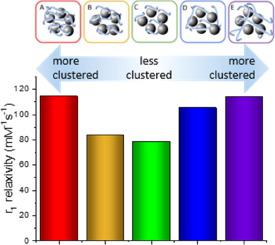Journal of Colloid and Interface Science ( IF 9.9 ) Pub Date : 2020-06-10 , DOI: 10.1016/j.jcis.2020.06.036 Aaron M King 1 , Caroline Bray 2 , Stephen C L Hall 2 , Joseph C Bear 3 , Lara K Bogart 4 , Sebastien Perrier 2 , Gemma-Louise Davies 1

|
The use of bio-polymers as stabilising agents for iron oxide-based negative magnetic resonance imaging (MRI) contrast agents has become popular in recent years, however the wide polydispersity of biologically-derived and commercially available polymers limits the ability to produce truly tuneable and reproducible behaviour, a major challenge in this area. In this work, stable colloids of iron oxide nanoparticles were prepared utilising precision-engineered bio-polymer mimics, poly(2-acrylamido-2-methylpropane sodium sulfonate) (P(AMPS)) polymers, with controlled narrow polydispersity molecular weights, as templating stabilisers. In addition to producing magnetic colloids with excellent MRI contrast capabilities (r2 values reaching 434.2 mM−1 s−1 at 25 °C and 23 MHz, several times higher than similar commercial analogues), variable field relaxometry provided unexpected important insights into the dynamic environment of the hydrated materials, and hence their exceptional MRI behaviour. Thanks to the polymer’s templating backbone and flexible conformation in aqueous suspension, nanocomposites appear to behave as “multi-core” clustered species, enhancing interparticle interactions whilst retaining water diffusion, boosting relaxation properties at low frequency. This clustering behaviour, evidenced by small-angle X-ray scattering, and strong relaxometric response, was fine-tuned using the well-defined molecular weight polymer species with precise iron to polymer ratios. By also showing negligible haemolytic activity, these nanocomposites exhibit considerable potential for MRI diagnostics.
中文翻译:

探索精密聚合物以微调氧化铁纳米粒子的磁共振成像特性。
近年来,将生物聚合物用作基于氧化铁的负磁共振成像(MRI)造影剂的稳定剂已成为现实,但是,生物衍生的和市售聚合物的广泛多分散性限制了其生产真正可调谐和稳定的聚合物的能力。可复制的行为,这是该领域的主要挑战。在这项工作中,使用精密工程化的生物聚合物模拟物,具有受控的窄多分散性分子量的聚(2-丙烯酰胺基-2-甲基丙烷磺酸钠)(P(AMPS))聚合物作为模板,制备了稳定的氧化铁纳米粒子胶体。稳定剂。除了生产具有出色的MRI对比功能的磁性胶体(r 2值达到434.2 mM -1 s -1在25°C和23 MHz下,比类似的市售类似物高出几倍),可变场弛豫法为水合材料的动态环境提供了意想不到的重要见解,并因此证明了其出色的MRI行为。得益于聚合物的模板骨架和在水悬浮液中的柔性构象,纳米复合材料似乎表现为“多核”簇状物种,既增强了粒子间的相互作用,又保留了水的扩散,增强了低频下的松弛性能。这种聚集行为由小角度X射线散射和强烈的弛豫响应所证明,是使用定义明确的分子量聚合物种类和精确的铁对聚合物比率进行微调的。通过显示微不足道的溶血活性,这些纳米复合材料在MRI诊断中显示出巨大潜力。


























 京公网安备 11010802027423号
京公网安备 11010802027423号